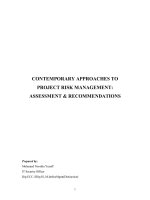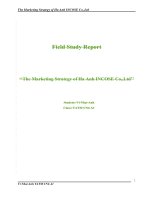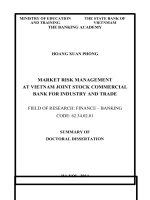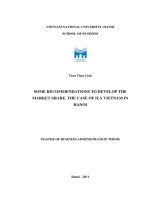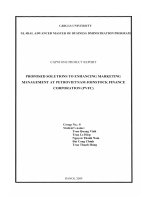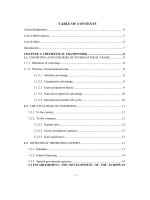some recommendations to strengthen risk management at COMA-IMEX
Bạn đang xem bản rút gọn của tài liệu. Xem và tải ngay bản đầy đủ của tài liệu tại đây (385.78 KB, 43 trang )
Trần Minh Phương – CQ503768 – Business English 50A
TABLE OF CONTENTS
TABLE OF ABBREVIATIONS............................................................................i
TABLE OF FIGURES ..........................................................................................ii
EXECUTIVE SUMMARY..................................................................................iii
INTRODUCTION..................................................................................................1
1.
Introduction of the research topic...........................................................1
2.
Purpose and scope of the research...........................................................1
3.
Research questions....................................................................................2
4.
Methodology..............................................................................................2
CHAPTER 1: INTRODUCTION.........................................................................3
1.1
An overview of COMA-IMEX.................................................................3
1.1.1
History and development of COMA-IMEX................................................3
1.1.2
Functions and missions...............................................................................3
1.1.3
Organizational structure..............................................................................4
1.2.
Overview of risk management in international payment at
COMA-IMEX...........................................................................................5
1.2.1
International payment reality in recent years.............................................5
1.2.2
Reality of risks at COMA-IMEX................................................................6
CHAPTER 2: THEORETICAL FRAMEWORK...............................................8
2.1
Key terms and definitions........................................................................8
2.1.1
International payment.................................................................................8
2.1.2
Risks...........................................................................................................8
2.1.3
Risks in international payment....................................................................9
2.2
Commercial risks......................................................................................9
2.2.1.
Risks to sellers..........................................................................................10
2.2.2.
Risks to buyers..........................................................................................10
2.3.
Risks in payment (financial risks).........................................................12
2.3.1.
Credit risk.................................................................................................13
2.3.2
Country risk..............................................................................................13
2.3.3.
Legislative risk..........................................................................................15
Trần Minh Phương – CQ503768 – Business English 50A
2.3.4.
Foreign exchange risk...............................................................................15
2.3.5
Interest rate risk........................................................................................16
2.3.6
Risk of selecting unsuitable conditions while negotiating international
payment terms...........................................................................................18
CHAPTER 3: FINDINGS AND ANALYSIS.....................................................19
3.1
Business results in recent years..............................................................19
3.1.1.
Reality of financial general status and business operation at COMAIMEX........................................................................................................19
3.1.2.
Overall assessment of COMA-IMEX’s real situation of international
payment....................................................................................................21
3.2.
Reality of risk management at COMA-IMEX......................................24
3.2.1.
Types of risks which COMA-IMEX often faced with..............................24
3.2.2.
Preventive solutions to risks which have been used so far at COMAIMEX........................................................................................................27
3.3.
Overall assessment of risk management in international payments
.................................................................................................................. 29
3.3.1.
Achievements...........................................................................................29
3.3.2.
Failures.....................................................................................................30
CHAPTER 4: RECOMMENDATION...............................................................31
4.1.
Suitable methods of payment.................................................................31
4.2.
Suitable currency in payment................................................................31
4.3.
Payment methods diversification...........................................................32
4.4.
Choosing partners...................................................................................32
4.5.
Human resources....................................................................................33
4.6.
Relationship with banks.........................................................................34
4.7.
Selecting and negotiating import/export contract conditions..............35
4.8.
Strengthening COMA-IMEX’s business and position.........................35
4.9.
Others......................................................................................................36
CONCLUSION.....................................................................................................37
REFERENCES
Trần Minh Phương – CQ503768 – Business English 50A
TABLE OF ABBREVIATIONS
COMA-IMEX
Construction Machinery Corporation – Import Export
Centre
L/C
Letter of Credit
Incoterms
International Commercial terms
UCP
The Uniform Customs and Practice for documentary
credits
WTO
World Trade Oganization
ISBP
International Standard Banking Practice
E/R
Earning/Revenue
T/T
Telegraphic Transfer
D/P
Documents against payment
D/A
Documents against acceptance
CIF
Cost & Insurance & Freight
i
Trần Minh Phương – CQ503768 – Business English 50A
TABLE OF FIGURES
Table 1 –
Business statistics at COMA-IMEX from 2009-2011.........................19
Chart 2 -
Main sources of revenue at COMA IMEX (2009-2011).....................21
Table 2 –
Prime cost in USD and JPY (2009-2010)............................................22
Table 3 –
E/R percentage of COMA-IMEX from 2009-2011.............................22
Chart 3 -
Percentage of Sales from import/export..............................................23
ii
Trần Minh Phương – CQ503768 – Business English 50A
EXECUTIVE SUMMARY
International payment nowadays is very important yet risky. Risk
management is issue which managers pay much attention to, especially managers
of import-export firms.
The purpose of this study is to detemine the financial risks and commercial
risks which COMA-IMEX, an import-export enterprise now facing with and what
feasible solutions COMA-IMEX should take to solve them.
The report is divided into four chapters.
In chapter 1, the researchers give a brief presentation on the establishment
and development of Construction Machinery Import Export Center (COMA-IMEX)
and introduction about their functions, missions and the company’s structure. In
additions, there are overview of risk management at COMA-IMEX in recent years.
In chapter 2, the researchers present theoretical framework which is
supported to the report. This chapter covers key terms and definitions of risk
management, types and classification of risks, etc.
Then, in chapter 3, by doing research of financial status and business
statement of COMA-IMEX, the researchers gives comments on reality of
import/export business at COMA-IMEX as well as COMA-IMEX’s achievement
and failures.
Finally, in chapter 4, the researchers makes some recommendations to
strengthen risk management at COMA-IMEX
iii
Trần Minh Phương – CQ503768 – Business English 50A
INTRODUCTION
1. Introduction of the research topic
In the speedy-growing economic world nowadays, it is essential that every
country integrates in order to narrow the rich-poor gap between developed and
developing countries. Pacific Asia, in the recent years, has been the most dynamic
part of the economic world. Being a nation in this area, Vietnam is not out of the
trend. One of the most important long-term strategies of Vietnam after joining WTO
is import-export promotion. Through import-export business, Vietnam will be able
to bring the world domestic goods, to gain foreign currencies, as well as to create
more jobs, and to decrease the unemployment rate, etc. It is undeniable that doing
import-export helps Vietnam speed up the economics improvement.
In the course of conducting import and export business, payment transaction
plays an extremely important role: it is essential for running the contract smoothly.
The payment transaction holds direct influences on capital turnover, reproducing
process, investment and profits of the company. However, there are many
difficulties and complex problems which happen during the payment transaction,
such as policy risk, exchange risk, credit risk, interest rate risk, etc. These problems
can only be predicted and solved with professional experiences and good technical
skills.
In particular, prevention of financial risks in business activities in general
and in international payment is an important task for all enterprises, including
COMA-IMEX. Therefore, “How to prevent financial risks in international payment
transaction?” has become a question for managers. That is the reason why I am
doing my research: “Risk management in the international payment at COMAIMEX”.
2. Purpose and scope of the research
The research has been carried out during my internship with helps from
managers of COMA-IMEX and under the instruction of Mrs. Nguyen Thi Thanh
Van. Due to the limit scope, the report mainly aims at:
Analyzing general business as well as import/export business of
COMA-IMEX from 2009-2011
Researching and analyzing risk management methods that COMAIMEX has been used so far
Suggesting some solution to improve efficiency of risk management
at COMA-IMEX
1
Trần Minh Phương – CQ503768 – Business English 50A
3.
Research questions
There are 2 questions which the research deals with:
1. What is the reality of risk management in international payment at
COMA-IMEX in recent years?
2. How can COMA-IMEX improve the risk management in international
payment?
4.
Methodology
The research has been carried out using data from financial reports of
COMA-IMEX from 2009 to 2011, course books about international payment,
international trade and risk management from well-known scholars. Observations as
well as interviews are important method which researchers use to work on the
report.
2
Trần Minh Phương – CQ503768 – Business English 50A
CHAPTER 1
INTRODUCTION
1.1 An overview of COMA-IMEX
1.1.1 History and development of COMA-IMEX
COMA-IMEX is one of 29 members of Construction Machinery Corporation
that specializes in machinery trading, established by Decision no.1027/QDBXD dated 07.26.2000 from the Minister of Construction. The Construction
Machinery Corporation is a state owned enterprise established in accordance with
the Decision No.993/BXD-TCLD dated November 20th 1995 issued by the
Minister of Ministry of Construction, basing on the former Union of Construction
Machinery Enterprise founded in 1975.
The international name of the center is IMPORT EXPORT CENTRE,
abbreviated as COMA-IMEX. The centre has been registered with certification of
business registration no 313597 from Hanoi Planning Committee on Sep 5th 2000.
Currently, COMA-IMEX is located at 13th floor, COMA building, Lane Hoa
Binh 6, 125D Minh Khai, Hai Ba Trung district, Hanoi.
1.1.2 Functions and missions
1.1.2.a. COMA-IMEX’s functions
- Organize activities of sending Vietnamese experts and worker to work short
term oversea with permission from Ministry of Construction
- Import goods such as: machines, raw materials… as the market demands
- Activities involves financial leasing
1.1.2.b. COMA-IMEX’s missions
- Organize short-term courses to improve management skills as well as
technical skills and foreign languages for employers
- Negotiate and perform business contracts on foreign trade and other
economic contracts
- Labour export
3
Trần Minh Phương – CQ503768 – Business English 50A
1.1.3 Organizational structure
There is a simple structure inside COMA-IMEX with 29 personnel in total 1 General Director, 2 Deputy Directors, functional departments with a manager and
a deputy manager of each department… as described below:
Chart 1 – Organizational Structure of COMA-IMEX
The Board of Director including General Director and two Deputy
Directors are responsible for controlling and commanding all business activities of
COMA-IMEX.
Accounting Department is responsible for staff salary payment and
other accounting activities; administrative business, receptions, monitoring and
maintaining working facilities... are also included in their responsibilities.
Import/Export Sales Department advises and helps Director on
import/export business; does other works that involves import/export as required by
Director
Labour Export Department advises and helps Director on labour
exporting by contracts
Training Department is responsible for training and organizing
courses to provide employees with skills and knowledge before sending them
abroad. All other training-involved works are their responsibilities
4
Trần Minh Phương – CQ503768 – Business English 50A
Labour Management Department assists Director in managing
labours working short term aboard, deals with other issues involving exported
employees’ benefits and disputes during and after their working durations
All departments and employees are expected to do other works as
General Director requires
1.2. Overview of risk management in international payment at COMAIMEX
1.2.1 International payment reality in recent years
In recent years, the main goods to export at COMA-IMEX are small metallic
details such as keys, door-hinges while main goods to import are heavy construction
machineries of all kind. Importing machinery is also main source of revenue at
COMA-IMEX in latest years, due to the high price of these kinds of goods (a
contract to import one unit of construction machinery may reach the number of
US100,100 in basis value, when COMA-IMEX sell the imported machine, profit
may be in range of 5% to 10% of the contract)
In 2009, revenue from sales of imported goods is 21,612,278,060VND while
revenue from exporting is only 2,369,702,668VND, which takes only 9.88% of the
total revenue (23,981,980,728VND). Revenue from importing is 10 times more than
exporting, which means in 2009, importing is COMA-IMEX’s key business.
In 2010 and 2011, importing is still COMA-IMEX’s key revenue, but the
difference between import and export has been narrowed. In 2010, revenue from
importing is down to 15,791,573,880VND (71.73% of total revenue) but export
activities brought COMA-IMEX 6,222,191,144VND (28.27%) which means nearly
as half as revenue from importing goods. Last year (2011), both revenue from
import and export increased rapidly which led the total revenue jumped up as twice
as in 2010. Export revenue in 2011 is about one third of revenue from importing.
From the numbers above, researchers point out that COMA-IMEX’s
financial condition is quite healthy, main business – importing – brings COMA
growing and stable revenue. However, COMA-IMEX is gradually improving its
field of exporting, the unbalance between import and export is less and less, which
have been proved in the year of 2010. In 2010, revenue from importing decrease
sharply, if it was not for increasing revenue of export then COMA-IMEX cannot
reached that high total revenue
5
Trần Minh Phương – CQ503768 – Business English 50A
1.2.2 Reality of risks at COMA-IMEX
1.2.2.a Some cases of risks which COMA-IMEX often faced
On Apr 4th 2009, COMA-IMEX signed a contract no 68/COMA/FOSHAN
with trade company Foshan to import 5.000m2 of Double Low E tempered glass
CIF at Haiphong port worth 845,000.00USD. This contract was to serve the project
of Indoor Game Hall to celebrate 1000 years anniversary of Thang Long - Hanoi.
Delivery time was within 120 days from the date of opening L/C. On June 18th
2009, the Ministry of Construction declared Circular No. 11/2009/TT-BXD on
"Regulation of the management quality of products, goods and construction glass."
Among the content of regulations and circulars pointed out that:
"The importer must provide the customs authorities at the border gate all the
certificate of:
+ Assessing the control system of quality from manufacturer in accordance
with ISO 9001: 2008;
+ Assessing the quality of product samples, glass at the border gate building
must be in accordance with the quality standards setting out in this Circular;"
Indeed, circulars issued by the Ministry of Construction aims to build
technical barriers to trade (TBT). Like in other countries, there are three specific
purposes on this circular: to help protect production, protect consumers and
preserve the ecological environment in the country, and deal with the barriers of the
other countries in international trade which are more and more modern and
sophisticated (such as case of Thailand: Thailand launched the hygiene standards of
food safety, regulation and registration of labeling foods for processed foods which
are very complex and caused foreign exporters a lot of time and cost; another
example is China where there are many strict regulations on hygiene and health at
the border and ports which create many difficulties to seafood exports).
However, the contract had signed before Circular No.11 /2009/TT-BXD
promulgated so COMA-IMEX not able to respond in time the seller's ship came to
port. In additions, FOSHAN is just a commercial company who is unable to define
whether their products meet the requirement as in ISO 9001:2008 or not.
In the situation above, not only country risk that COMA-IMEX faced with
but also other commercial risk arises such as: delay in unloading goods, more
expenses for storage fee, goods are unable to import so COMA-IMEX was unable
to deliver goods in time to provide the project of Indoor Game Hall.
6
Trần Minh Phương – CQ503768 – Business English 50A
1.2.2.b Preventive solutions to risks which COMA-IMEX has used so far
Using the stable and strong currencies in international payment and using
forward contracts, futures contracts are some of preventive solutions to exchange
rate risk which COMA-IMEX often used.
In order to prevent commercial risks, COMA-IMEX often in preference to
trade with familiar, prestigious customers and partners than new ones. During
negotiation about contract’s terms, COMA-IMEX always point out that the delivery
time is as soon as possible, it is often more than 3 months since the contract is
signed.
Nowadays, due to Government’s policy of foreign currency, getting foreign
currencies to use in import/export business is a big problem to import/export
enterprises like COMA-IMEX. To have stable sources of currencies, COMA-IMEX
has to buy from outside markets and re-sell to banks, or makes some agreement
with banks so that they can provide the company with USD or JPY in time.
7
Trần Minh Phương – CQ503768 – Business English 50A
CHAPTER 2
THEORETICAL FRAMEWORK
2.1 Key terms and definitions
2.1.1 International payment
As described in encyclopedia from thefreedictionary.com (a prestigious
academic website), below is how international payment understood:
Payment made between countries, whether in settlement of a trade debt, as a
unilateral transfer of funds, for capital investment, or for some other purpose. The
reasons for such payments and the methods of making them and accounting for them are
matters of concern to economists and national governments. International debts are
settled either from accumulated balances of foreign currency or claims on foreign
currency, or by loans from creditor to debtor, or by drawing on the International
Monetary Fund, or by movements of gold. How a country balances its international
accounts is one of the most important decisions for its balance of payments.
According to Dr. Nguyen Van Tien (2011), Head of International
Department, Banking Academy, international payment is implementation of doing
payments and rights of monetary benefits which occurs through relationships of
concerned banks, due to economic and non-economic activities, between
organizations and foreign organizations, or individuals and foreign individuals, or
between a country and an international organization.
2.1.2 Risks
Risk is threat of danger, damage, injury… which can be raised during many
kind of actions in real life … In business life, breakdowns and accidents happen out
of a sudden may cause serious troubles and great loss of human or property. All
of those unexpected incidents are called risks. When talking about risks, it is often
about loss of physical assets caused by external or internal vulnerabilities.
There are some preventive methods to deal with risks:
Avoid risks: which means do nothing risky or uncertain. This method cannot
be used in business because avoiding risks equal to gaining nothing, no profit and
being rejected in competition. Since “high risk, high profit”, risks cannot be swept
out totally in doing business.
Prevent and reduce risks: by using preventive methods to minimize risks
such as fire alarm systems, labour safety… and studying rules and regulations in
economy, a company or manager will be able to reduce risks even though risks are
not disappear completely.
8
Trần Minh Phương – CQ503768 – Business English 50A
Standby funds: spend a fixed amount of money to create a fund to use in case
risks happen. Pros: companies will be self-prepared. Cons: it is difficult to raise
enough money for the funds if a great risk happens; moreover, standby funds may
leads to dead capital
Risks transfer: organizations or individuals hire professional insurance
companies to be responsible for their risks
2.1.3 Risks in international payment
During the process of international payment, or in the process of
import/export business, there are many chances that risks will happen. There are
more than one ways to classify risks in international payment as well as ways to
define and evaluate them. They can be classified by causes or by involved parties
(when different methods of international payment are considered). In Multinational
Business Finance 10th Edition, risks are divided by range of influences:
(David K. Eiteman, Arthur I. Stonehill and Michael H. Moffett, 2003)
In my report, risks will be divided by causes of risks into the two main types
of risks that import/export firms in Vietnam often faced with: Commercial Risk and
Risk in Payment (Financial risk)
2.2 Commercial risks
Definition of Commercial risk: “The risk that a debtor will be unable to pay
its debts because of business events, such as bankruptcy” (Campbell R. Harvey,
2011). This type of risk shows in every business deal, even domestic business.
9
Trần Minh Phương – CQ503768 – Business English 50A
Commercial risks in international payment are similar to risks occurs in domestic
business but more complicated and higher risky. It can be considered differently
from different sides of seller and buyers.
In the lecture of “Risk management”, Võ Hữu Khánh, MA. (2011) pointed
out and classified commercial risks very clearly as below:
2.2.1. Risks to sellers
Mistakes in payment
Buyer’s poor finance or inability of paying
Buyers’ inability to pay within the agreed time, when their funds run out
of money, they may ask for extension of repayment.
The payment may be compromised if the buyer can not improve their
financial situation immediately.
The legislation: in cases that the buyers can no longer claim payment, that
enterprise shall be dissolved by law. Exporter's debts are paid only after priority
debts are settled such as debts of wages, debts of social organization, unpaid taxes...
There is very little chance for exporter to recover their money that buyer owed
them, even very small amounts. Facing with the loss of the buyer's payment ability,
there are few solutions unless sellers do effective measures of safety on payment
before making commercial contracts, or buy insurance from companies who
responsible for this problem.
2.2.2. Risks to buyers
2.2.2.1.
There are risks to buyer when violations of contract happen such
as:
a. Delay in shipment which affects business
Any delay caused by internal or external reasons such as delays in
shipment caused by natural disasters or accidents, or changes in shipment or
payment terms, changes in transportations…will affect business badly
b. Changes of payment terms
Lead to changes in plans and create difficulties (particularly in case
buyers pay with loans from banks). Sometimes, sellers unilaterally change the terms
of payment and force buyers to pay once for all before shipping.
10
Trần Minh Phương – CQ503768 – Business English 50A
c. Partial shipment
If not in special cases, partial shipment should not be allowed because the
drawback to this kind of shipment is its expense. The cost for transporting a great
amount of goods always be more economic than several smaller packages
d. Changes in prices
Higher prices compared to original prices in contract will lead to contract
cancel or the buyers have to suffer a loss from the higher price. In this case the
buyers may refuse to continue the contract and find another supplier but this
solution still makes delivery behindhand.
e. Risks in insurance
Lack of controlling may lead to serious breakdowns in shipment, in that
case, even the money that insurance company pay to make up for goods has reached
the highest level, it is still too low compared to real value of goods
f. Quality of goods:
Any difference in quality of good compared to what has been signed in
documents will be considered inappropriate, which causes troubles to buyers in
relationships between the buyers and involved parties (such as authorities, customs,
customers…)
g. Origin of goods
Certificate of Origin is unchangeable, which means the origin of goods
cannot be differ from one that signed in the contract.
h. Unhygienic state of goods:
In case the performance testing for safety and hygiene of goods does not
meet the medical requirement as in seller’s certificate, those goods cannot be
imported
i. Stocking costs
When the bill of lading arrives after goods did, the buyers cannot get the
delivery without documents and have to pay amount of storage fee
j. Quantity of goods
When the buyers receive less than what they demanded in contract,
obviously the lost goods cause them troubles for not gaining profit or slowing down
project progress. In addition, buyers still bear loan interest from bank.
11
Trần Minh Phương – CQ503768 – Business English 50A
If the buyers import goods in order to sell to a third party, the contract
between buyers and third party may be cancelled and buyers’ reputation will be
damaged
If the received quantity is bigger than one in contract, buyers have to pay
more taxes and sometimes get trouble by being accused of tax evasion
2.2.2.2. Reasons for commercial risks
a. Lack of information
Because of geographic distance between sellers and buyers, parties lack
of information about each other and cannot be sure about the ability of payment or
progress of contract performance
b. Lack of knowledge
Trade laws are differ from country to country, all trade laws and UCP,
Incoterms, ISBP… should be understood well in order to prevent commercial risks
from happening.
2.3. Risks in payment (financial risks)
Investopedia.com defines financial risk as “The risk that a company will not
have adequate cash flow to meet financial obligations”. Another way of
understanding is that financial risk is any risk that comes from lending people or
entity money or selling them goods without receiving money first… (Farlex
Financial Dictionary, 2011). In another words, financial risks are the probability
that an actual return on an investment will be lower than the expected return
(businessdictionary.com). Financial risks also concern one company being unable to
pay off the debt to another company.
Financial risks in international payment are economic risks happen during
international payment transactions, this is the reason why they are also called Risks
in Payment. The reasons come from relationship between partners in the operation
such as sellers, buyers, banks… or other intermediary factors
Risks in payment include unpredictable incidents that affects both sellers and
buyers badly or even banks which provide international payment services to
involved parties
12
Trần Minh Phương – CQ503768 – Business English 50A
2.3.1. Credit risk
2.3.1.1. Definition
According to Campbell R. Harvey (2011), credit risk is the risk that an issuer
of debt securities or a borrower may default on its obligations, or that the payment
may not be made on a negotiable instrument. David L. Scott explained in “Wall
Street Words: An A to Z Guide to Investment Terms for Today's Investor” that
credit risk is the risk that a borrower will be unable to make payment of interest or
principal in a timely manner (2003)
Credit risks affect business results of the company badly. When debts are not
paid partly or totally by scheduled, sellers will be in troubles, especially when credit
risks combine with exchange rate risk and risk of interest.
2.3.1.2. Reasons for credit risk:
The competitive market nowadays is among external reasons for credit risk.
Price changes, outdated technology and equipment, financial crisis or global
regression… create domino effect which affects many companies with difficulties,
losses or even bankruptcy.
Internal reasons are lack of information and poor management and
administration skills. If a seller or buyer does not have a thorough grasp of partner’s
financial situation and ability of payment or does not know well about international
payment and the project they are doing, then credit risk is unable to be avoided.
2.3.2 Country risk
2.3.2.1. Definition
Political situations and economic policies, foreign exchange management
policies of a country may change from time to time. Those changes affect both
sellers and buyers; sometimes they prevent buyers from getting payment and sellers
from getting delivery.
General understanding of country risk is probability of loss due to economic
and/or political instability in the buyer's country, resulting in an inability to pay for
imports (businessdictionary.com). Below is another definition of country risk in
Farlex Financial Dictionary (2011):
The risk that a foreign government will significantly alter its policies or other
regulations so that it negatively impacts the business climate in that country or the
returns on a particular industry, company, or project. Macro-country risk deals with
policy changes that harm, say, exporters or foreign-owned businesses in general,
while micro-country risk implies that a government will deliberately target a
particular company or way of making a living. For example, the political climate of
13
Trần Minh Phương – CQ503768 – Business English 50A
a country in which defense contractors operate may turn against one particular
company because of its perceived excesses or against defense contractors in
general. This may cause the government revoke contracts for one or more defense
contractors
Recession and currency crisis of a country or an area play an important role
to international payment of any import-export company. They are unexpected
situations which will lead to the reduction or loss of liquidity of the contracts signed
earlier. Besides, bank account embargo and blockade applied to accounts in foreign
banks make company’s international payment more difficult, delayed or even lose
ability to pay. When there are country risks, there are often credit risks, interest
risks… go along with them and make them more serious.
Country risks to buyers happen when buyers want to pay sellers but
unexpected economic or politic incidents appear which make the buyers’
Government forbid them to pay foreign currencies to foreign companies, or
imported goods are listed as not subjected to customs clearance.
Country risks to sellers happen when there are changes in policy of foreign
trade or customs in sellers’ country. The sellers are ready to export but upheavals
happen such as tax for exporting increases or the to-be-exported goods are
forbidden to export which make exportation postponed.
2.3.2.2. Reasons for country risk:
Conflicts of race, political parties, religion threaten the stability of a country.
Demonstrations, strikes, riots, wars.
The problem of foreign debt forces the importing government to use strong
measures to forbid foreign payment or transfer foreign currency abroad.
Bad situations such as foreign currency reserves at a low level and the
national balance of international payments face the heavily deficit force the
Government of the importing country to take action to stop foreign payments
immediately.
The economic international embargo on importing country puts all
international activities and the Nostro accounts of the importing countries
under strict control, or even be blocked so that banks cannot pay for foreign
countries.
Foreign exchange management policy of importing countries suddenly
changes, foreign exchange policy is tighten or forbidden in payment which
poses risks to importers and their banks.
14
Trần Minh Phương – CQ503768 – Business English 50A
2.3.3. Legislative risk
2.3.3.1. Definition
Legislative risk is a risk occurs when there is a dispute or claim coming from
the involved parties. The issue raised is that which country's court is going to handle
the case and of which country will the law base on.
Definition of legislative risk:
Risk that a change in legislation could have a major positive or negative effect on an
investment. For instance, a company that is a large exporter may be a beneficiary of a trade
agreement that lowers tariff barriers, and therefore may see its stock price rise. On the other
hand, a company that is a major polluter may be harmed by laws that stiffen fines for
polluting the air or water, thereby making its share price fall.
(John J. Capela, Stephen Hartman, 2011)
2.3.3.2. Reasons for legislative risk:
Since there are differences in legal environment and the laws between parties
and parties, no matter what international documentary credit selected which adjusts
payment method selected (UCP-600 or not), in various countries this transaction
was also adjusted and dominated by legal system of the local country. UCP and the
laws of the countries altogether create a legal framework for L/C transaction of
commercial banks in general when participating in international payment. However,
the applying levels of each country are different up to the law of that country.
Indeed, when there is a conflict between a term in L/C (no matter it follows
UCP or not) and legal law of a country, the national legal law will be followed and
disclaim UCP. Or another way of saying: the applying of UCP into L/C does not
deny legal law and cannot prevent the Court from applying national legal law
(Dr.Nguyen Van Tien, 2010)
2.3.4. Foreign exchange risk
2.3.4.1. Definition
This type of risk often happens in L/C which requires fix kind of currency.
When there is a change about exchange rate of that currency, sellers or buyers will
get loss. If the price of fixed currency increases then the buyers will suffer a loss,
vice versa, the sellers will get loss. Below is definition of foreign exchange risk,
according to David L. Scott (2003):
The risk that the exchange rate on a foreign currency will move against the position
held by an investor such that the value of the investment is reduced. For example, if
an investor residing in the United States purchases a bond denominated in Japanese
yen, a deterioration in the rate at which the yen exchanges for dollars will reduce
15



